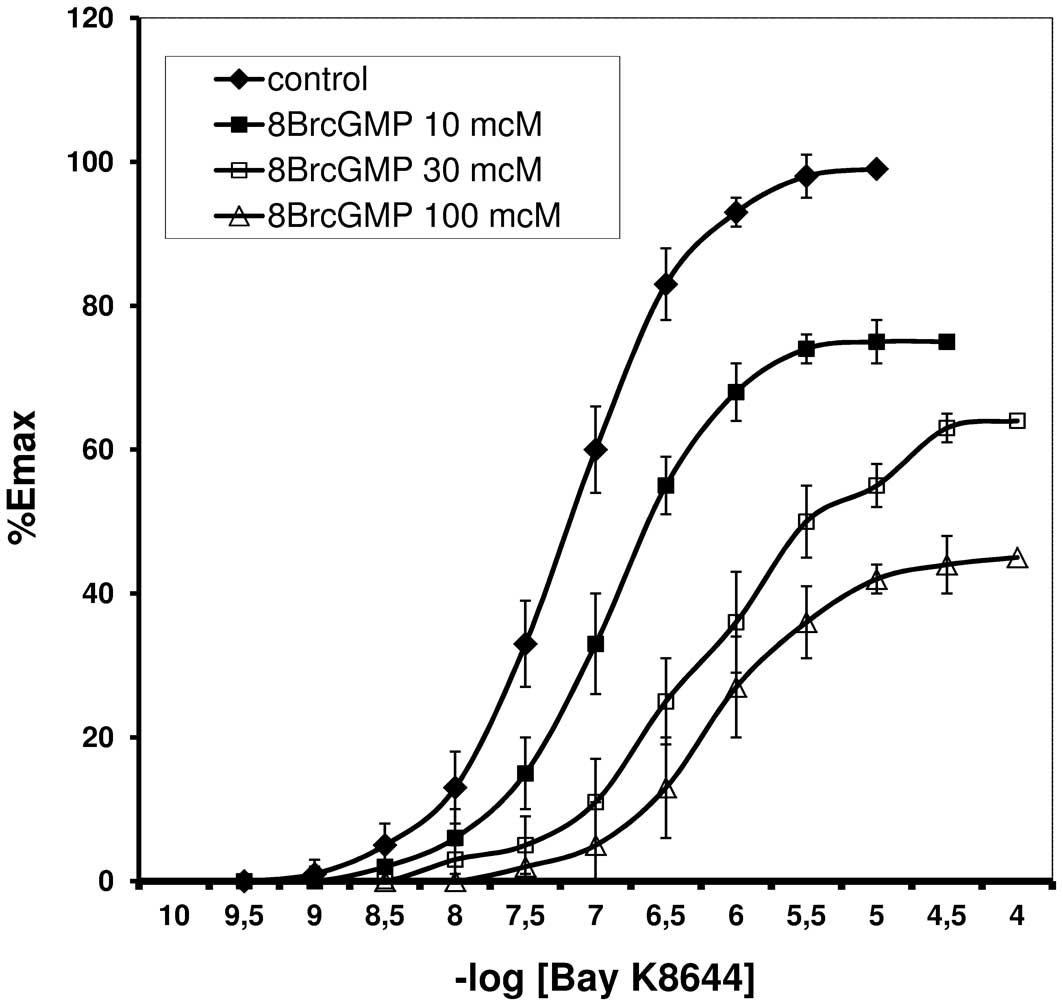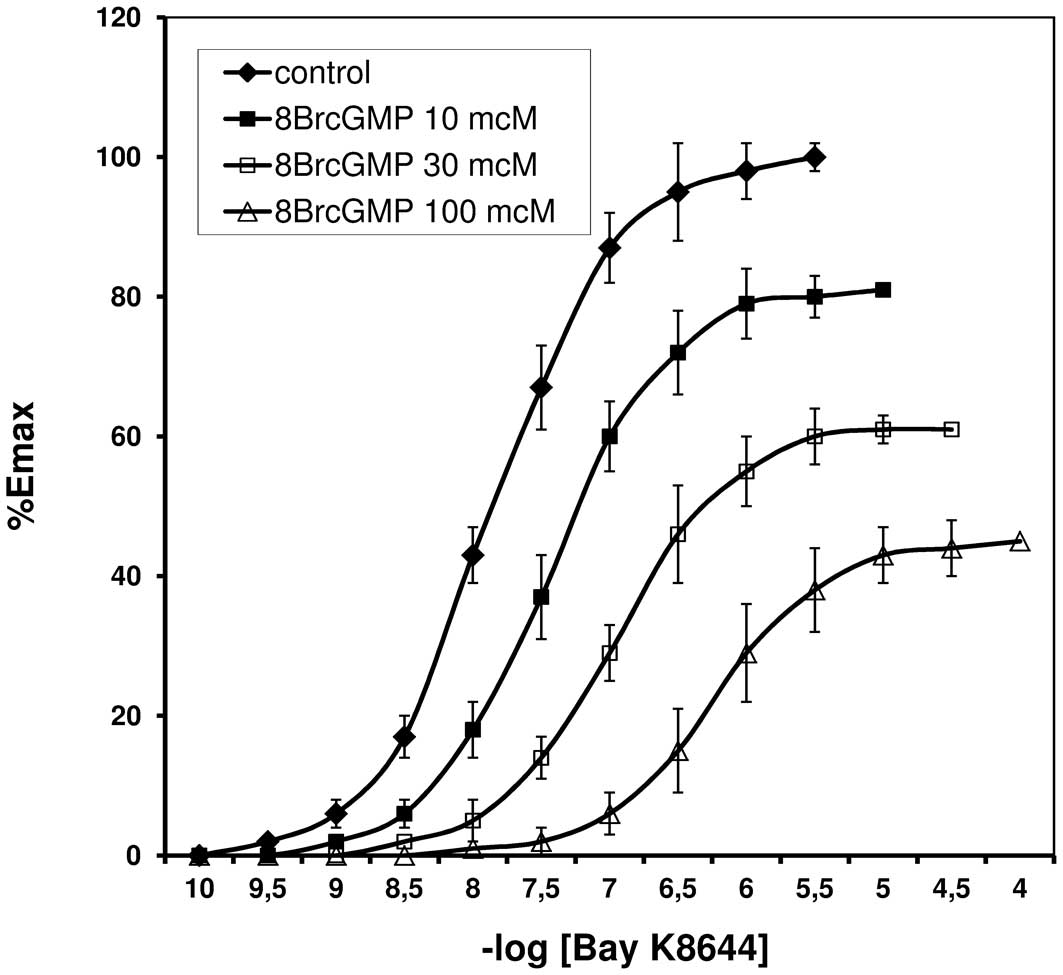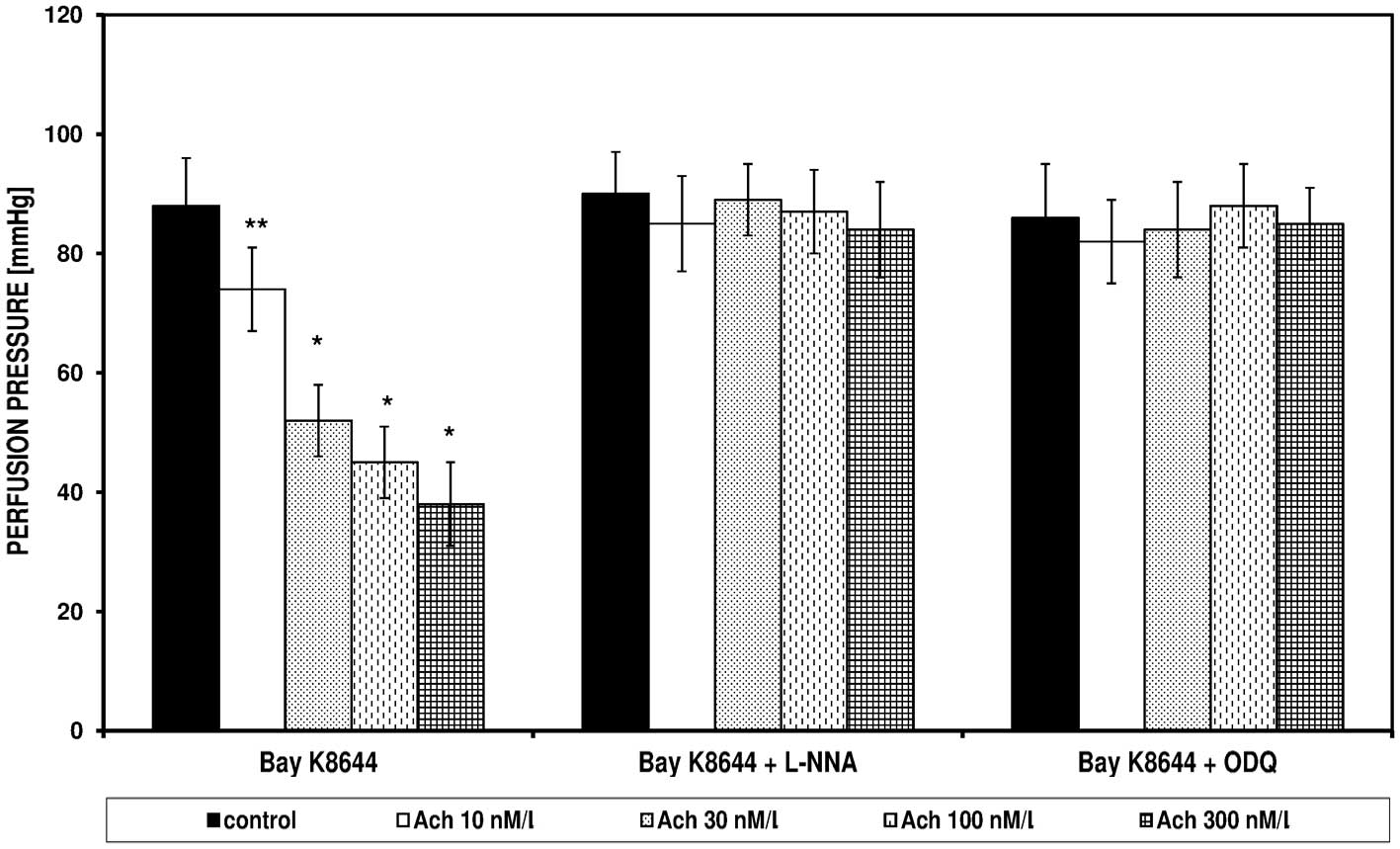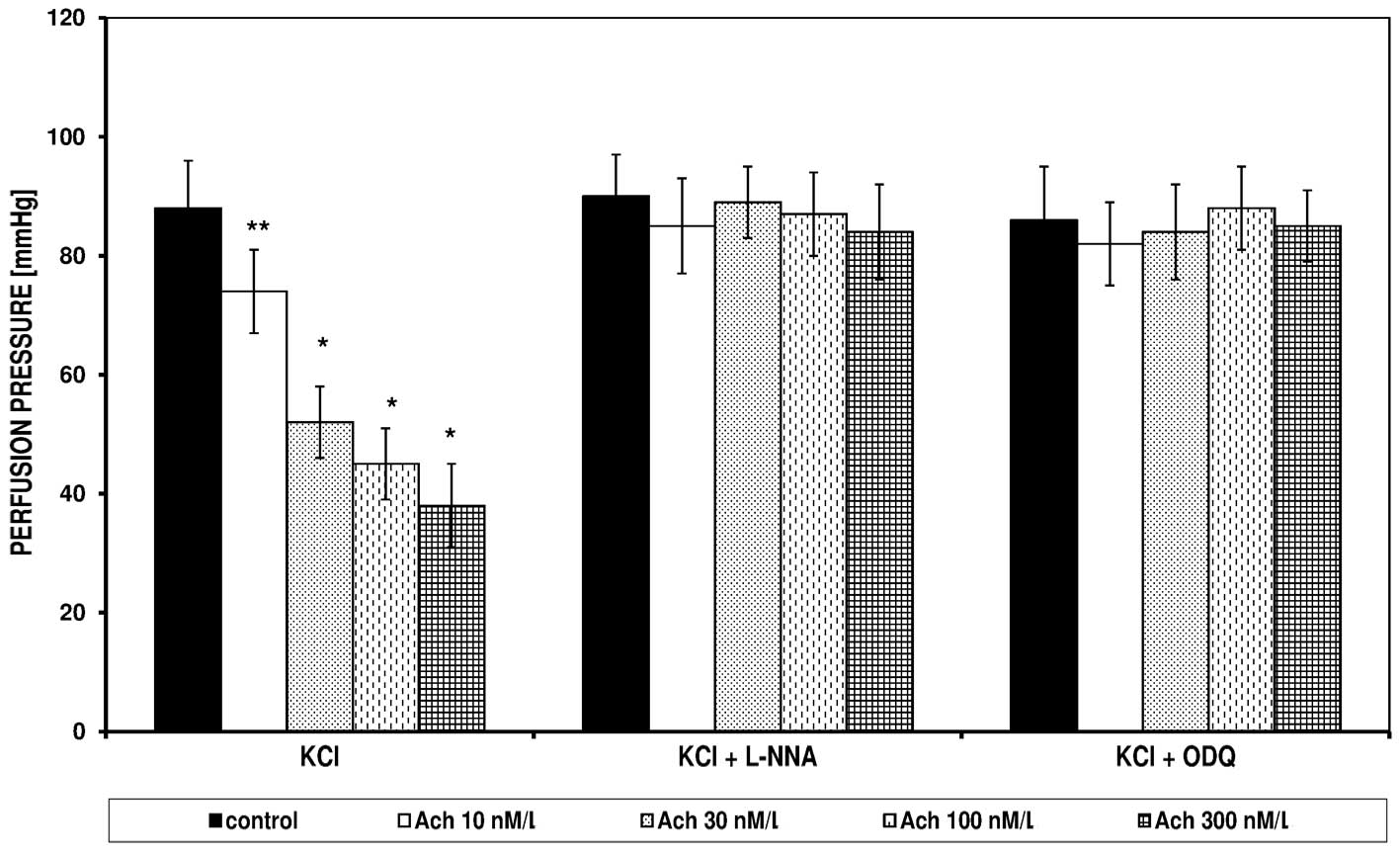Role of endothelium, acetylocholine and calcium ions in Bay K8644- and KCl-induced contraction
- Authors:
- Published online on: July 8, 2013 https://doi.org/10.3892/mmr.2013.1574
- Pages: 914-918
Abstract
Introduction
The structure of the arteries is important as serve as a target for a number of substances that regulate smooth muscle tension. The endothelium is a cell layer that lines the inside of blood vessels, and also produces and releases mediators that modulate the contraction of arteries (1,2).
Endothelial damage occurs in the course of various pathological processes, particularly atherosclerosis, and leads to vascular disorders with regard to diameter regulation, which potentially result in occlusion of the vessels. Although platelet aggregation is a natural recovery process following the injury of blood vessel walls, activation of the coagulation system following plaque rupture may result in a reduction or complete elimination of blood flow. Nitric oxide (NO) is a vasodilator agent that is produced by the endothelial cells by constitutive NO synthase (3). In smooth muscle cells, NO activates soluble guanylyl cyclase (GC) and the resulting increase in cyclic guanosine monophosphate (cGMP) levels leads to blood vessel dilatation (4,5). This effect may be as a result of the reduction in the concentration of Ca2+ in the cytoplasm (due to the influx of calcium into the cell or the inhibition of the release of calcium from intracellular stores), dephosphorylation of myosin light chains or interaction with the contractile system (6–10). The release of NO occurs under physiological conditions; however, it may be further stimulated by various factors, such as acetylcholine (Ach), bradykinin and histamine (11).
The aim of this study was to determine the significance of the signaling pathway associated with Ach in the contraction induced via the extracellular pool of Ca2+ by Bay K8644 (an agonist of calcium channels located in the cell membrane) and KCl (at depolarizing concentrations), and also to determine the importance of the vascular endothelium in the activity of Bay K8644.
Materials and methods
Reagents
The study was performed on perfused male Wistar rat tail arteries. Rats, weight 250–350 g, were narcotized by intraperitoneal injection of 120 mg/kg of body mass. After being dissected and cleared from the surrounding tissue, 2.5–3-cm long segments of rat tail arteries were cannulated and connected to perfusion apparatus. Perfusion pressure was measured continuously. The distal part was weighted with a 500 mg weight and placed in a 20 ml container filled with oxygenated Krebs solution at 37°C. The perfusion solution flow was gradually increased using a peristaltic pump until 1 ml/min was reached.
Two types of Krebs fluid were used in this study to determine the importance of the intracellular and extracellular pools of Ca2+ in the reactions induced by Bay K8644 (30 μM/l) and KCl (110 mM/l) under control conditions, following the addition of nitro-L-arginine (L-NNA; nitric oxide synthase, 10 μM/l) or 1H-(1,2,4)oxadiazolo(4,3-a)quinoxalin-1-one (ODQ; an inhibitor of soluble guanylyl cyclase; 10 μM/l), and in the presence of increasing Ach concentrations. The two Krebs solutions were as follows: i) fluid without Ca2+-EGTA [Krebs (no calcium); calcium-free physiological salt solution, FPSS]; and ii) fluid with Ca2+-EGTA [Krebs (normal); physiological salt solution, PSS]. The composition of the fluid without Ca2+-EGTA was as follows: NaCl (71.8 mM/l), KCl (4.7 mM/l), NaHCO3 (28.4 mM/l), MgSO4 (2.4 mM/l), KH2PO4 (1.2 mM/l), glucose (11.1 mM/l) with the addition of EGTA (30 μM/l). The composition of the fluid with Ca2+-EGTA was as follows: NaCl (71.8 mM/l), KCl (4.7 mM/l), CaCl2 (1.7 mM/l), NaHCO3 (28.4 mM/l), MgSO4 (2.4 mM/l), KH2PO4 (1.2 mM/l), glucose (11.1 mM/l) with addition of EGTA (30 μM/l), following the emptying of the intracellular pool of Ca2+. All reagents were purchased from Sigma-Aldrich (Poznań, Poland).
Removal of the endothelium
In a number of cases, the endothelium of the arteries was removed using compressed air to determine the importance of the endothelium in the responses induced by Bay K8644 and following the addition of increasing concentrations of 8Br-cGMP (12).
Concentration-response curves (CRCs)
CRCs were determined using the van Rossum method of increasing concentrations (12). Dose-dependency was determined for arteries with and without endothelium under control conditions and in the presence of 8Br-cGMP (10, 30 and 100 μM/l). The concentration of 8Br-cGMP that resulted in the half maximal effective concentration (EC50) was determined using the method of linear regression for 20–80% maximal effect. Vessel contraction was measured as increase in perfusion pressure.
Ethical compliance
The Guiding Principles for the Care and Use of Animals in the Field of Physiological Sciences as well as specific national law were followed. The study was approved by the Ethics Committee for the Affairs of Experiments on Animals in Bydgoszcz (no. 1/2008-4).
Statistical analysis
Results are presented as the mean ± standard deviation. Statistical differences were analyzed using the Student’s t-test. P<0.05 was considered to indicate a statistically significant difference.
Results
Bay K8644 induced contraction of the rat tail arteries with and without endothelium. CRCs for Bay K8644, in the presence of 8Br-cGMP are shown in Figs. 1 and 2. The resulting EC50 values are listed in Table I.
Table IEC50 values for Bay K8644 in the presence of 8Br-cGMP (experiments performed on arteries with/without endothelium). |
In the FPSS group, perfusion pressure under the influence of Bay K8644 and KCl did not change; the pressures were 14±6 and 15±5 mmHg, respectively (data not shown). Bay K8644 and KCl in the PSS induced an increase of perfusion pressure, which was significantly reduced in the presence of Ach (Figs. 3 and 4). The spasmolytic Ach action did not occur in the presence of L-NNA and ODQ. Figs. 3 and 4 present the effect of increasing concentrations of Ach on the perfusion pressure induced in the PSS by Bay K8644 and KCl, respectively, in the presence of L-NNA and ODQ.
Discussion
Arterial tension is dependent upon the structure and function of each layer of the arterial wall, the availability of Ca2+ and the presence of certain vasodilator and vasoconstrictor factors. Endothelial NO is important in the induction of vasodilation (1), and acts through a signaling system involving cGMP (4,5). Bay K8644 and KCl are agents that stimulate blood vessel contraction by inducing an influx of Ca2+ into the cells through channels in the cell membrane. In the present study, the role of the endothelium in vascular contraction induced by Bay K8644 and the involvement of the Ach/NO/cGMP cascade in Bay K8644 and KCl activity were investigated.
Arterial spasm induced by Bay K8644 was demonstrated to be reduced by 8Br-cGMP, in a dose-dependent manner. The CRCs were shifted to the right with increasing 8Br-cGMP concentrations. Similar changes in the shape and position of the CRCs were demonstrated in the experiments performed in arteries without endothelium, thus the reaction was determined to be independent of this layer of the vessel wall. Similar findings were observed in previous studies, which utilized angiotensin II (ANG II) as a substance that stimulated vessel contraction (13,14). These studies also demonstrated that in arteries without endothelium, in contrast to vessels with an intact inner layer, no inhibition of ANG II-stimulated contraction following ischemia was observed. Numerous studies have confirmed that ischemia/reperfusion results in an impaired endothelial function, which reduces the synthesis of endothelial vasodilatators, such as prostaglandins and NO (15–18).
Under these conditions, vasodilatation stimulated by Ach, bradykinin, adenosine-5′-diphosphate (ADP), serotonin and thrombin, among others, is disturbed; however, the effect of NO donors remains to be observed (17,19). In the present study, experiments in FPSS and PSS demonstrated that Bay K8644 and KCl induce an increase in the perfusion pressure, due to an influx of Ca2+ from outside of the cell, as observed in previous studies (20–23). Other studies have indicated that KCl (at depolarizing concentrations) and Bay K8644 contract smooth muscle by opening the Ca2+ L-type channels located in the cell membrane, and by increasing concentrations of free Ca2+ in the cytoplasm. This effect may be eliminated in the presence of calcium channel Ca2+ antagonists, nifedipine and diltiazem (24–27). Subsequent experiments demonstrated that the contraction induced by Bay K8644 and KCl in the PSS was reduced at increasing Ach concentrations, and this effect was eliminated in the presence of L-NNA (nitric oxide synthase inhibitor) or ODQ (an inhibitor of soluble GC). In addition, similar observations have been demonstrated in studies of human mesenteric arteries (22). Ji et al demonstrated that Ach blocked phenylephrine-triggered contraction of endothelium-intact rat aorta, but did not affect the responses of arteries without endothelium (28).
The studies have also indicated that L-NNA and methylene blue (an inhibitor of soluble GC) may abolish the spasmolytic action of Ach. It was demonstrated that KCl stimulates the influx and increase of the calcium ion concentration in the cytoplasm, and also increases the myosin light chain kinase activity (29–31). However, the cellular mechanism of contraction induced by KCl remains to be elucidated.
This mechanism of action was the basis for the use of KCl in the present study investigating cell signaling as a factor in cell membrane depolarizing (electromechanical coupling), compared with agents that stimulate muscle contraction when combined with the corresponding receptors (pharmacomechanical coupling) (31,32). Other studies have demonstrated that KCl may lead to the release of Ca2+ from intracellular stores (33,34). It was also shown that membrane depolarization alone led to the sensitivity to Ca2+(35). Studies have indicated that KCl also blocked the myosin light chain phosphatase through RhoA kinase activation, which led to the sensitivity of Ca2+(36–38).
Signal pathways that control smooth muscle tension remain an important focus of research, as the mechanisms regulating vascular contraction may contribute to the understanding of physiological and pathological processes in the circulatory system, and may also be beneficial in determining novel treatment methods for cardiovascular diseases.
In conclusion, it was demonstrated that the increase in vascular tone induced by Bay K8644 and KCl was independent of the intracellular pool of Ca2+. The relaxant effect of Ach on the responses stimulated by Bay K8644 and KCl indicated that NO was involved in modulating the reactivity of the arteries to the examined factors, which contributes to the influx of Ca2+ into the cell.
References
|
Furchgott RF and Zawadzki JW: The obligatory role of endothelial cells in the relaxation of arterial smooth muscle by acetylcholine. Nature. 288:373–376. 1980. View Article : Google Scholar : PubMed/NCBI | |
|
Lüscher TF and Barton M: Biology of the endothelium. Clin Cardiol. 20(Suppl 2): II-3–II-10. 1997. | |
|
Palmer RM, Ashton DS and Moncada S: Vascular endothelial cells synthesize nitric oxide from L-arginine. Nature. 333:664–666. 1988. View Article : Google Scholar : PubMed/NCBI | |
|
Furchgott RF and Vanhoutte PM: Endothelium-derived relaxing and contracting factors. FASEB J. 3:2007–2018. 1989.PubMed/NCBI | |
|
Murad F: The nitric oxide-cyclic GMP signal transduction system for intracellular and intercellular communication. Recent Prog Horm Res. 49:239–248. 1994.PubMed/NCBI | |
|
Blatter LA and Wier WG: Nitric oxide decreases [Ca2+]i in vascular smooth muscle by inhibition of the calcium current. Cell Calcium. 15:122–131. 1994. | |
|
Collins P, Griffith TM, Henderson AH and Lewis MJ: Endothelium-derived relaxing factor alters calcium fluxes in rabbit aorta: a cyclic guanosine monophosphate-mediated effect. J Physiol. 381:427–437. 1986. View Article : Google Scholar | |
|
Karaki H, Sato K, Ozaki H and Murakami K: Effects of sodium nitroprusside on cytosolic calcium level in vascular smooth muscle. Eur J Pharmacol. 156:259–266. 1988. View Article : Google Scholar : PubMed/NCBI | |
|
McDaniel NL, Chen XL, Singer HA, Murphy RA and Rembold CM: Nitrovasodilators relax arterial smooth muscle by decreasing [Ca2+]i and uncoupling stress from myosin phosphorylation. Am J Physiol. 263:C461–C467. 1992. | |
|
Murad F: Cyclic guanosine monophosphate as a mediator of vasodilation. J Clin Invest. 78:1–5. 1986. View Article : Google Scholar : PubMed/NCBI | |
|
Moncada S, Palmer RM and Higgs EA: Nitric oxide: physiology, pathophysiology, and pharmacology. Pharmacol Rev. 43:109–142. 1991. | |
|
Van Rossum JM: Cumulative dose-response curves. II Technique for the making of dose-response curves in isolated organs and the evaluation of drug parameters. Arch Int Pharmacodyn Ther. 143:299–330. 1963.PubMed/NCBI | |
|
Koller A, Sun D, Huang A and Kaley G: Corelease of nitric oxide and prostaglandins mediates flow-dependent dilation of rat gracilis muscle arterioles. Am J Physiol. 267:H326–H332. 1994.PubMed/NCBI | |
|
Szadujkis-Szadurska K, Slupski M, Szadujkis-Szadurski R, Szadujkis-Szadurski L, Jasiñski M and Kolodziejska R: The role of the endothelium in the regulation of vascular smooth muscle cell contractions induced by angiotensin II after ischemia and reperfusion. Arch Pharm Res. 33:1019–1024. 2010. View Article : Google Scholar : PubMed/NCBI | |
|
Dignan RJ, Dyke CM, Abd-Elfattah AS, Lutz HA, Yeh T Jr, Lee KF, Parmar J and Wechsler AS: Coronary artery endothelial cell and smooth muscle dysfunction after global myocardial ischemia. Ann Thorac Surg. 53:311–317. 1992. View Article : Google Scholar : PubMed/NCBI | |
|
Fullerton DA, Hahn AR, Koike K, Banerjee A and Harken AH: Intracellular mechanisms of pulmonary vasomotor dysfunction in acute lung injury caused by mesenteric ischemia-reperfusion. Surgery. 114:360–367. 1993.PubMed/NCBI | |
|
Fullerton DA, Mitchell MB, McIntyre RC Jr, Banerjee A, Campbell DN, Harken AH and Grover FL: Cold ischemia and reperfusion each produce pulmonary vasomotor dysfunction in the transplanted lung. J Thorac Cardiovasc Surg. 106:1213–1217. 1993.PubMed/NCBI | |
|
Hashimoto K, Pearson PJ, Schaff HV and Cartier R: Endothelial cell dysfunction after ischemic arrest and reperfusion: a possible mechanism of myocardial injury during reflow. J Thorac Cardiovasc Surg. 102:688–694. 1991.PubMed/NCBI | |
|
Dauber IM, VanBenthuysen KM, McMurtry IF, Wheeler GS, Lesnefsky EJ, Horwitz LD and Weil JV: Functional coronary microvascular injury evident as increased permeability due to brief ischemia and reperfusion. Circ Res. 66:986–998. 1990. View Article : Google Scholar : PubMed/NCBI | |
|
Pesic A, Madden JA, Pesic M and Rusch NJ: High blood pressure upregulates arterial L-type Ca2+ channels: is membrane depolarization the signal? Circ Res. 94:e97–e104. 2004. View Article : Google Scholar : PubMed/NCBI | |
|
Pratt PF, Bonnet S, Ludwig LM, Bonnet P and Rusch NJ: Upregulation of L-type Ca2+ channels in mesenteric and skeletal arteries of SHR. Hypertension. 40:214–219. 2002. | |
|
Szadujkis-Szadurski R, Tafil-Klawe M, Szadujkis-Szadurska K, Szadujkis-Szadurski L, Slupski M, Grzesk G, Matusiak G, Gajdus M and Glaza I: Modulation of the contractile effect of Bay K8644 on human vascular smooth muscle cells by acetylocholine and calcium ions. Med Biol Sci. 24:59–64. 2010. | |
|
Szadujkis-Szadurska K, Grzesk G, Szadujkis-Szadurski L, Gajdus M and Matusiak G: Role of nitric oxide and cGMP in modulation of vascular contraction induced by angiotensin II and Bay K8644 during ischemia/reperfusion. Exp Ther Med. 5:616–620. 2013.PubMed/NCBI | |
|
Iesaki T and Wolin MS: Thiol oxidation activates a novel redox-regulated coronary vasodilator mechanism involving inhibition of Ca2+ influx. Arterioscler Thromb Vasc Biol. 20:2359–2365. 2000. View Article : Google Scholar : PubMed/NCBI | |
|
Matchkov VV, Aalkjaer C and Nilsson H: A cyclic GMP- dependent calcium-activated chloride current in smooth-muscle cells from rat mesenteric resistance arteries. J Gen Physiol. 123:121–134. 2004. View Article : Google Scholar : PubMed/NCBI | |
|
Piper AS and Large WA: Direct effect of Ca2+-calmodulin on cGMP-activated Ca2+-dependent Cl-channels in rat mesenteric artery myocytes. J Physiol. 559:449–457. 2004.PubMed/NCBI | |
|
Szadujkis-Szadurski L, Talar J, Wisniewski K, Tomaszewski W, Lukowicz M and Szadujkis-Szadurski R: Modulatory effects of laser radiation on extracellular and intracellular calcium pool and vascular resistance of rat’s tail artery. Physiother Pol. 2:11–20. 2002. | |
|
Ji J, Benishin CG and Pang PK: Nitric oxide selectively inhibits intracellular Ca2+ release elicited by inositol trisphosphate but not caffeine in rat vascular smooth muscle. J Pharmacol Exp Ther. 285:16–21. 1998.PubMed/NCBI | |
|
Brozovich FV: Rho signaling: agonist stimulation and depolarization come together. Circ Res. 93:481–483. 2003. View Article : Google Scholar : PubMed/NCBI | |
|
Liu C, Zuo J, Pertens E, Helli PB and Janssen LJ: Regulation of Rho/ROCK signaling in airway smooth muscle by membrane potential and [Ca2+]i. Am J Physiol Lung Cell Mol Physiol. 289:L574–L582. 2005.PubMed/NCBI | |
|
Somlyo AV and Somlyo AP: Electromechanical and pharmacomechanical coupling in vascular smooth muscle. J Pharmacol Exp Ther. 159:129–145. 1968.PubMed/NCBI | |
|
Karaki H, Ozaki H, Hori M, Mitsui-Saito M, Amano K, Harada K, Miyamoto S, Nakazawa H, Won KJ and Sato K: Calcium movements, distribution, and functions in smooth muscle. Pharmacol Rev. 49:157–230. 1997.PubMed/NCBI | |
|
Kobayashi S, Kanaide H and Nakamura M: Complete overlap of caffeine- and K+ depolarization-sensitive intracellular calcium storage site in cultured rat arterial smooth muscle cells. J Biol Chem. 261:15709–15713. 1986.PubMed/NCBI | |
|
Ureña J, del Valle-Rodríguez A and López-Barneo J: Metabotropic Ca2+ channel-induced calcium release in vascular smooth muscle. Cell Calcium. 42:513–520. 2007. | |
|
Yanagisawa T and Okada Y: KCl depolarization increases Ca2+ sensitivity of contractile elements in coronary arterial smooth muscle. Am J Physiol. 267:H614–H621. 1994.PubMed/NCBI | |
|
Ratz PH, Berg KM, Urban NH and Miner AS: Regulation of smooth muscle calcium sensitivity: KCl as a calcium-sensitizing stimulus. Am J Physiol Cell Physiol. 288:C769–C783. 2005. View Article : Google Scholar : PubMed/NCBI | |
|
Ratz PH and Miner AS: Role of protein kinase Czeta and calcium entry in KCl-induced vascular smooth muscle calcium sensitization and feedback control of cellular calcium levels. J Pharmacol Exp Ther. 328:399–408. 2009. View Article : Google Scholar : PubMed/NCBI | |
|
Sakurada S, Takuwa N, Sugimoto N, Wang Y, Seto M, Sasaki Y and Takuwa Y: Ca2+-dependent activation of Rho and Rho kinase in membrane depolarization-induced and receptor stimulation-induced vascular smooth muscle contraction. Circ Res. 93:548–556. 2003. |













